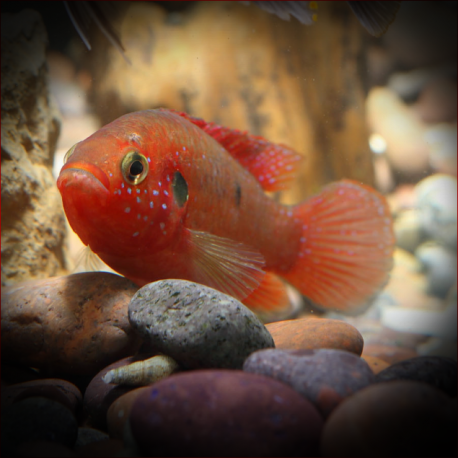More info
Datasheet
| Minimum Tank Size | 110 litres / 29.06 US gallons |
| Maximum Size | 15.0cm / 5.91inches |
| Temperature | 22°C / 71.60°F - 28°C / 82.40°F |
| Hardness | 4-18ºdH |
| pH | 6.0-7.8 |
General Description
The Jewel Cichlid, scientifically known as Hemichromis bimaculatus, is a species not typically recommended for beginners due to its territorial behavior and aggression, often mistakenly placed in community tanks. It is commonly confused with Hemichromis lifalili, distinguished by the number of black spots on their flanks - two for lifalili and three for bimaculatus.
Aquarium Setup
For Jewel Cichlids, a minimum tank size of 110 litres is necessary (see table), with a roomy layout offering numerous hiding places to disperse aggression. This setup can include clay flower pots, rock formations creating caves, sturdy plants, driftwood, and dense vegetation. The fish, being diggers, require firmly rooted plants or potted ones to prevent uprooting.
Behaviour
This species displays territorial behavior and heightened aggression during spawning. Jewel Cichlids can coexist with larger Alestiid tetras, Synodontis catfish, Loricariids, and potentially other African cichlids like Steatocranus in adequately sized tanks. It is advisable to introduce a group of young specimens and allow a pair to naturally form to prevent one fish from being killed due to dominance.
Feeding and Diet
Jewel Cichlids have a versatile diet and will consume various food offerings, although live foods are beneficial in enhancing their coloration. Including vegetable matter in their diet, such as vegetable/spirulina flakes or blanched spinach, is recommended for optimal health.
Reproduction & Dimorphism
Reproduction for Jewel Cichlids involves pair bonding, which can be challenging with adults. It is suggested to purchase a group of juveniles to enable natural pairing. Spawning occurs in a setup with large rocks acting as spawning sites, conditioned on a varied diet, with slightly acidic soft water conditions. Males exhibit reticulated patterning on their caudal fins, with pointed dorsal fins in adulthood, aiding in sexual dimorphism.
Habitat and Distribution
In the wild, Jewel Cichlids inhabit small streams and canals characterized by overhanging vegetation cover. Their distribution spans across Africa's western coast from South Guinea to Central Liberia, where they thrive in slightly soft and acidic waters with a temperature range of 22-28 degrees Celsius.

